600 BC to 600 AD, Anacreon, Petronius, Ovid, Herondas, etc.
-
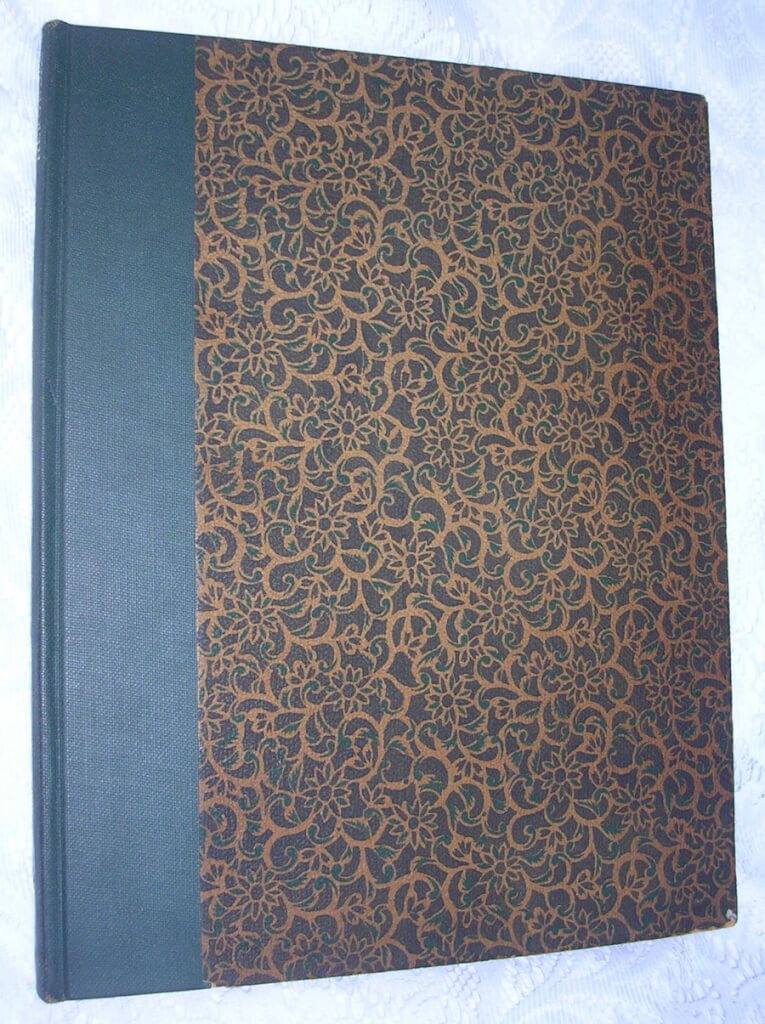
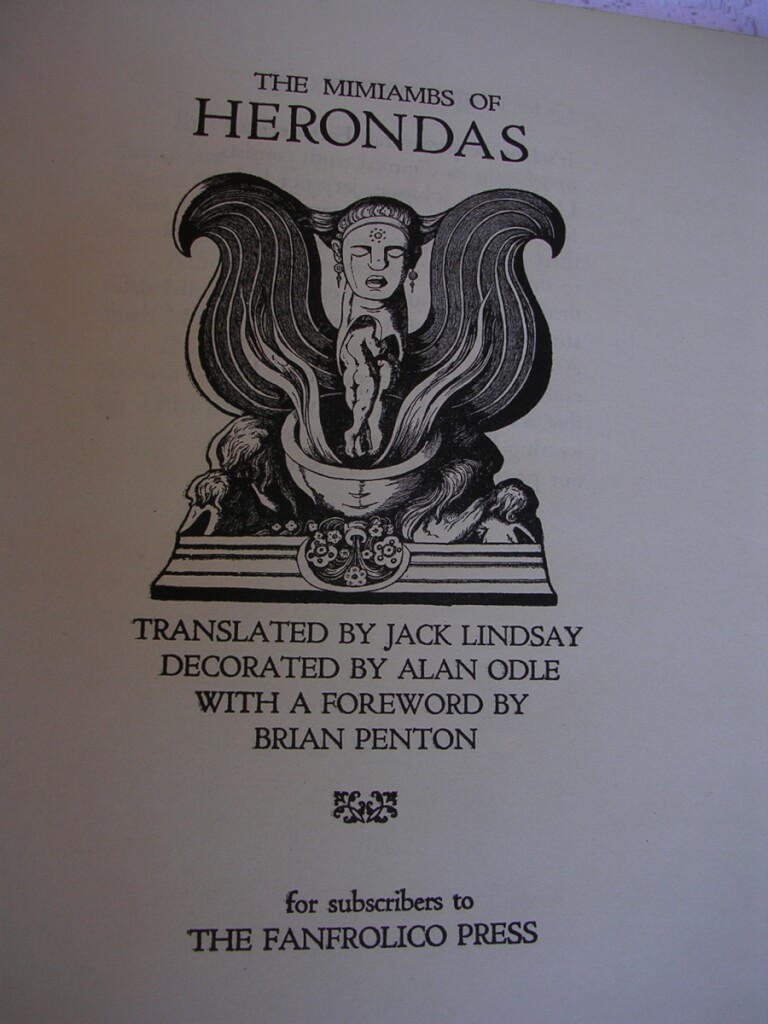 The Mimiambs of Herondas, Herodas, Translated by Jack Lindsay, Decorated by Alan Odle, with a Foreword by Brian Penton. (The Fanfrolico Press, London, nd [c. 1929], #106/375 [first edition, and first Fanfrolico to be printed in London]) 11 7/8" X 9 3/8", unpaginated 72pp, hardbound no DJ, original buckram-backed decorated Japanese paper boards with plain green cloth spine and gilt lettering, top edge gilt, other edges deckle, very good condition minor wear to bottom of boards, Cloister types on Van Gelder Antique handmade paper Herodas was a Greek poet and the author of short humorous dramatic scenes in verse, written under the Alexandrian empire in the 3rd century BC. Mimes were scenes in popular life in South Italy and Sicily, written in the language of the people, vigorous with racy proverbs such as we get in other reflections of that region. The Mimes of Herodas have been known to us only since the discovery and publication of the "Kenyon", M. S. Buck, by the British Museum in 1891 (from a parchment containing 7 legible mimes half of the 8th and a fragment of the 9th). This was Fanfrolico's first London book. It was published "for subscribers to The Franfrolico Press". This new translation of Mimiambs of Herondas was translated by Jack Lindsay and beautifully illustrated by Alan Odle whose grotesque and subversive style was a precursor of surrealism. This is a beautiful printed book in great condition and quite rare. Fanfrolico Press, Australia’s first ‘private press’ in the arts-and-craft tradition, was founded by Jack Lindsay, P. R. Stephensen and John Kirtley, originally in North Sydney in 1923. The press specialized in printings artful, limited editions of classics and forgotten works that were suited to the extravagant style of artist like his father, artist, sculptor and author Norman Lindsay who illustrated many of their books. Fanfrolico was scornful of modernism and with its florid style determinedly backward-looking. They did surprisingly well, despite the lack of business expertise of their young, ambitious "bohemian" owners, eking out a living despite the risky move to London in 1926 and upheavals in ownership that saw the departure in 1927 of Kirtley, and then Stephenson in 1929. Sometime in 1930 they published their last book.
The Mimiambs of Herondas, Herodas, Translated by Jack Lindsay, Decorated by Alan Odle, with a Foreword by Brian Penton. (The Fanfrolico Press, London, nd [c. 1929], #106/375 [first edition, and first Fanfrolico to be printed in London]) 11 7/8" X 9 3/8", unpaginated 72pp, hardbound no DJ, original buckram-backed decorated Japanese paper boards with plain green cloth spine and gilt lettering, top edge gilt, other edges deckle, very good condition minor wear to bottom of boards, Cloister types on Van Gelder Antique handmade paper Herodas was a Greek poet and the author of short humorous dramatic scenes in verse, written under the Alexandrian empire in the 3rd century BC. Mimes were scenes in popular life in South Italy and Sicily, written in the language of the people, vigorous with racy proverbs such as we get in other reflections of that region. The Mimes of Herodas have been known to us only since the discovery and publication of the "Kenyon", M. S. Buck, by the British Museum in 1891 (from a parchment containing 7 legible mimes half of the 8th and a fragment of the 9th). This was Fanfrolico's first London book. It was published "for subscribers to The Franfrolico Press". This new translation of Mimiambs of Herondas was translated by Jack Lindsay and beautifully illustrated by Alan Odle whose grotesque and subversive style was a precursor of surrealism. This is a beautiful printed book in great condition and quite rare. Fanfrolico Press, Australia’s first ‘private press’ in the arts-and-craft tradition, was founded by Jack Lindsay, P. R. Stephensen and John Kirtley, originally in North Sydney in 1923. The press specialized in printings artful, limited editions of classics and forgotten works that were suited to the extravagant style of artist like his father, artist, sculptor and author Norman Lindsay who illustrated many of their books. Fanfrolico was scornful of modernism and with its florid style determinedly backward-looking. They did surprisingly well, despite the lack of business expertise of their young, ambitious "bohemian" owners, eking out a living despite the risky move to London in 1926 and upheavals in ownership that saw the departure in 1927 of Kirtley, and then Stephenson in 1929. Sometime in 1930 they published their last book. -
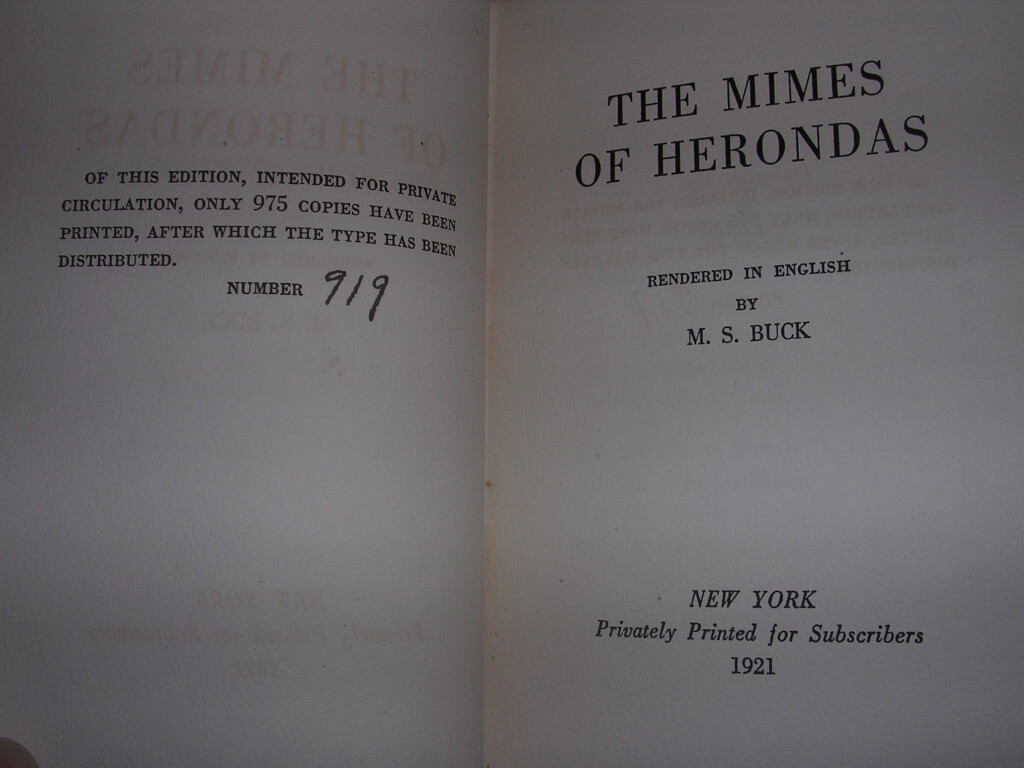
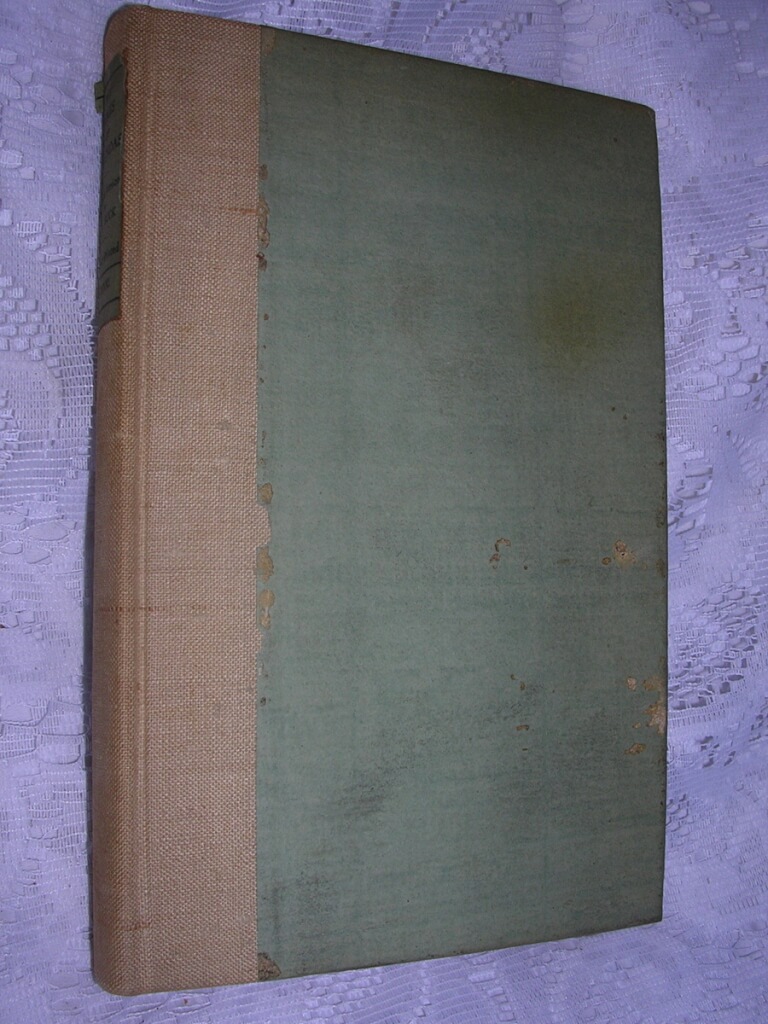 The Mimes of Herondas, trans. M. S. Buck (Privately Printed for Subscribers, New York, 1921, #70/975) 7" X 4 5/8", 119pp, hardbound no DJ, paper boards with beige cloth spine, top edge gilt, others deckle, good condition, lightly soiled Herodas was a Greek poet and the author of short humorous dramatic scenes in verse, written under the Alexandrian empire in the 3rd century BC. Mimes were scenes in popular life in South Italy and Sicily, written in the language of the people, vigorous with racy proverbs such as we get in other reflections of that region. The Mimes of Herodas have been known to us only since the discovery and publication of the "Kenyon", M. S. Buck, by the British Museum in 1891 (from a parchment containing 7 legible mimes half of the 8th and a fragment of the 9th).
The Mimes of Herondas, trans. M. S. Buck (Privately Printed for Subscribers, New York, 1921, #70/975) 7" X 4 5/8", 119pp, hardbound no DJ, paper boards with beige cloth spine, top edge gilt, others deckle, good condition, lightly soiled Herodas was a Greek poet and the author of short humorous dramatic scenes in verse, written under the Alexandrian empire in the 3rd century BC. Mimes were scenes in popular life in South Italy and Sicily, written in the language of the people, vigorous with racy proverbs such as we get in other reflections of that region. The Mimes of Herodas have been known to us only since the discovery and publication of the "Kenyon", M. S. Buck, by the British Museum in 1891 (from a parchment containing 7 legible mimes half of the 8th and a fragment of the 9th). -

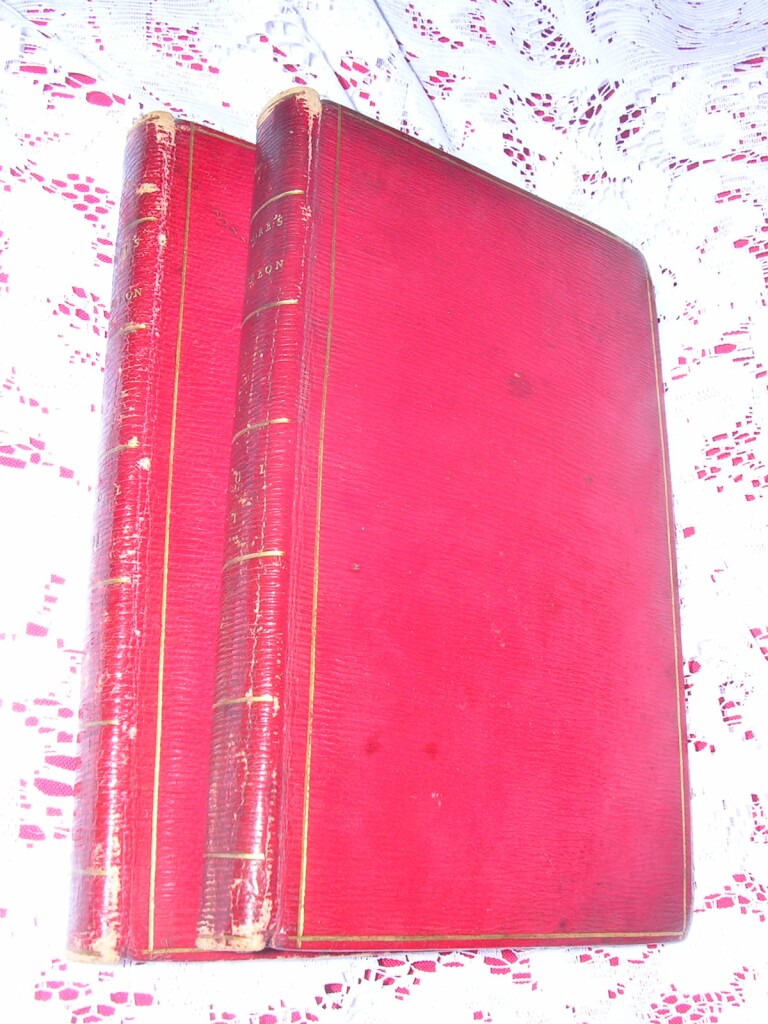 Odes of Anacreon, Anacreon, trans. Thomas Moore (J. and T. Carpenter, London, 1802) 6 1/2" X 4 1/4", 2 vol. 163pp 148pp, hardbound in red morocco with gilt lettering and decorations, gilted edges, marbled boards, worn edges and corners befitting it's age, binding tight, ribbon markers intact. Armorial bookplate of british judge, Geoffrey Lord Cross of Chelsea on front pastedowns Anacreon (582 BC _ 485 BC) was a Greek lyric poet, notable for his drinking songs and hymns. Later Greeks included him in the canonical list of nine lyric poets. Thomas Moore (1779 _ 1852) is considered Ireland's "National Bard". He was a poet, singer, songwriter, and entertainer. He was responsible, with John Murray, for burning Lord Byron's memoirs after his death. These books are the second edition (original edition published in 1800) of his first work, a translation that he did at Middle Temple where he studied law. In his lifetime he was often referred to as Anacreon Moore.
Odes of Anacreon, Anacreon, trans. Thomas Moore (J. and T. Carpenter, London, 1802) 6 1/2" X 4 1/4", 2 vol. 163pp 148pp, hardbound in red morocco with gilt lettering and decorations, gilted edges, marbled boards, worn edges and corners befitting it's age, binding tight, ribbon markers intact. Armorial bookplate of british judge, Geoffrey Lord Cross of Chelsea on front pastedowns Anacreon (582 BC _ 485 BC) was a Greek lyric poet, notable for his drinking songs and hymns. Later Greeks included him in the canonical list of nine lyric poets. Thomas Moore (1779 _ 1852) is considered Ireland's "National Bard". He was a poet, singer, songwriter, and entertainer. He was responsible, with John Murray, for burning Lord Byron's memoirs after his death. These books are the second edition (original edition published in 1800) of his first work, a translation that he did at Middle Temple where he studied law. In his lifetime he was often referred to as Anacreon Moore. -

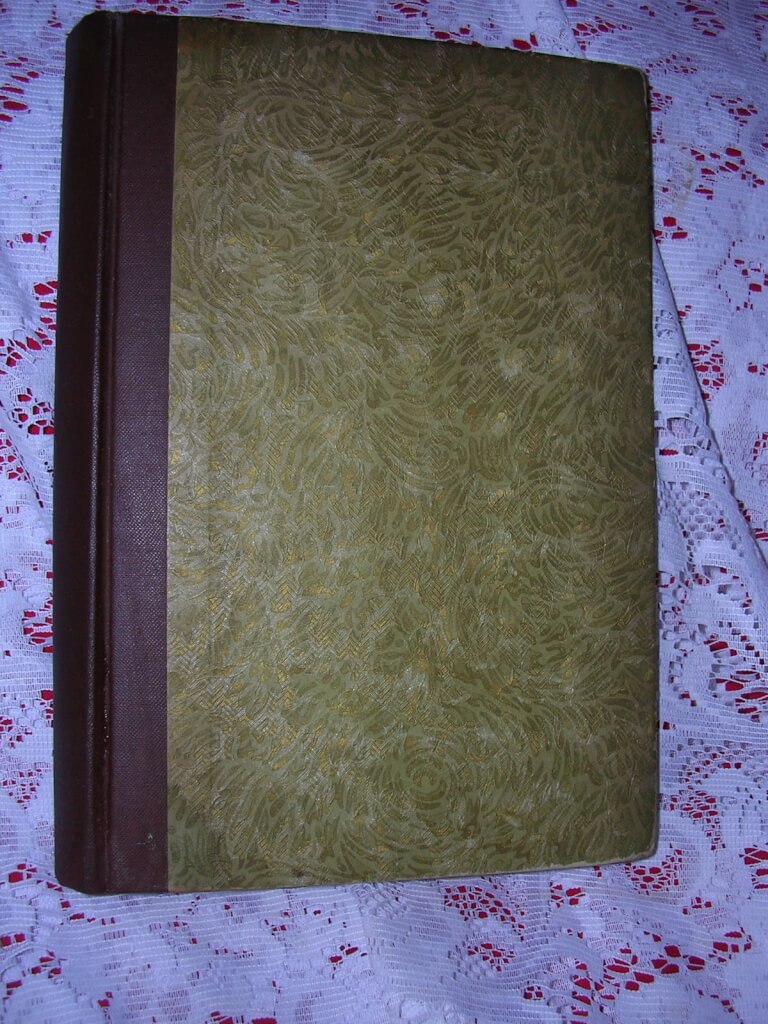 The Satyricon of Petronius Arbiter, Gaius Petronius, trans. ascribed to Oscar Wilde (Privately Printed, 1928, Limited Edition of 1200 unnumberd) 9" X 6 1/4", 236pp, Brown spine with gilt titles (mostly worn off), decorated boards with green and gilt. Deckle bottom and fore edges, top edge inked purple. Fair copy, spine cocked, binding and boards good, corners worn. Satyricon (or Satyrica) is a Latin work of fiction in a mixture of prose and poetry (prosimetrum). It is believed to have been written by Gaius Petronius, though the manuscript tradition identifies the author as a certain Titus Petronius. Classical scholars often describe it as a "Roman novel", without necessarily implying continuity with the modern literary form. The surviving portions of the text detail the misadventures of the narrator, Encolpius, and his lover, a handsome sixteen-year-old boy named Giton. Throughout the novel, Encolpius has a hard time keeping his lover faithful to him as he is constantly being enticed away by others. Encolpius's friend Ascyltus (who seems to have previously been in a relationship with Encolpius) is another major character. It is a rare example of a Roman novel, the only other surviving example (quite different in style and plot) being Metamorphoses of Apuleius. It is also extremely important evidence for the reconstruction of what everyday life must have been like for the lower classes during the early Roman Empire.
The Satyricon of Petronius Arbiter, Gaius Petronius, trans. ascribed to Oscar Wilde (Privately Printed, 1928, Limited Edition of 1200 unnumberd) 9" X 6 1/4", 236pp, Brown spine with gilt titles (mostly worn off), decorated boards with green and gilt. Deckle bottom and fore edges, top edge inked purple. Fair copy, spine cocked, binding and boards good, corners worn. Satyricon (or Satyrica) is a Latin work of fiction in a mixture of prose and poetry (prosimetrum). It is believed to have been written by Gaius Petronius, though the manuscript tradition identifies the author as a certain Titus Petronius. Classical scholars often describe it as a "Roman novel", without necessarily implying continuity with the modern literary form. The surviving portions of the text detail the misadventures of the narrator, Encolpius, and his lover, a handsome sixteen-year-old boy named Giton. Throughout the novel, Encolpius has a hard time keeping his lover faithful to him as he is constantly being enticed away by others. Encolpius's friend Ascyltus (who seems to have previously been in a relationship with Encolpius) is another major character. It is a rare example of a Roman novel, the only other surviving example (quite different in style and plot) being Metamorphoses of Apuleius. It is also extremely important evidence for the reconstruction of what everyday life must have been like for the lower classes during the early Roman Empire. -

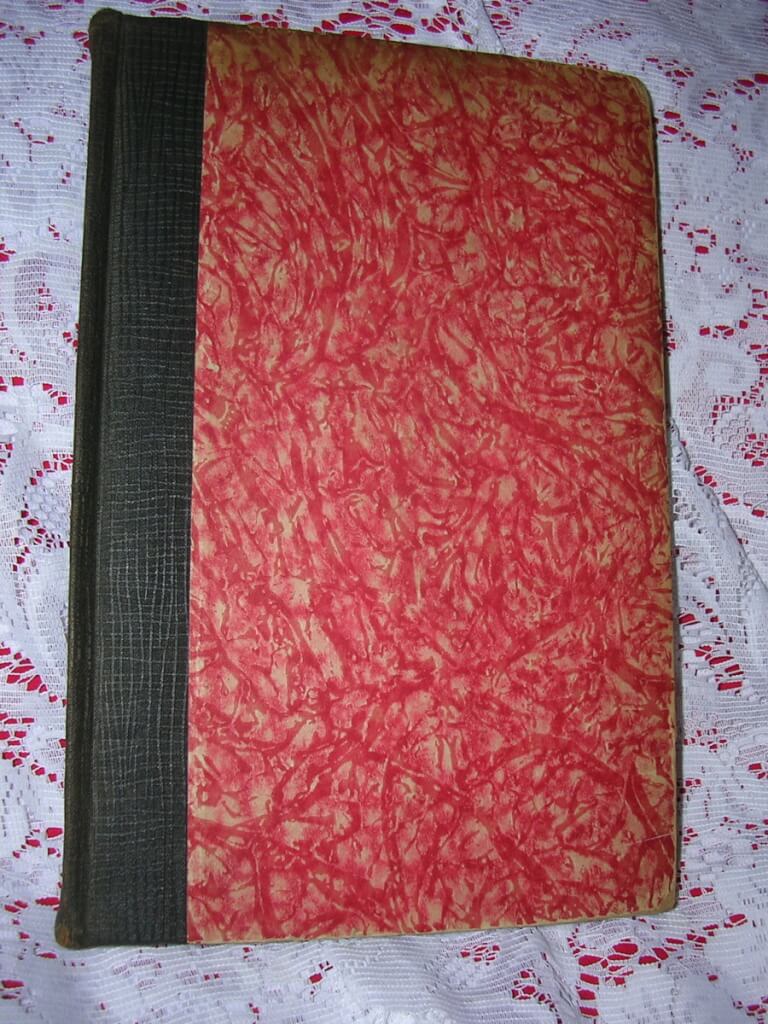 The Satyricon of Petronius Arbiter, Gaius Petronius, trans. ascribed to Oscar Wilde (Privately Printed, 1928, Limited Edition 343/1200 stamped in ink) 9" X 6 1/4", 236pp, black spine with gilt titles (mostly worn off), decorated red boards. Fair copy, boards worn, binding good. Front board loose but holding. Satyricon (or Satyrica) is a Latin work of fiction in a mixture of prose and poetry (prosimetrum). It is believed to have been written by Gaius Petronius, though the manuscript tradition identifies the author as a certain Titus Petronius. Classical scholars often describe it as a "Roman novel", without necessarily implying continuity with the modern literary form. The surviving portions of the text detail the misadventures of the narrator, Encolpius, and his lover, a handsome sixteen-year-old boy named Giton. Throughout the novel, Encolpius has a hard time keeping his lover faithful to him as he is constantly being enticed away by others. Encolpius's friend Ascyltus (who seems to have previously been in a relationship with Encolpius) is another major character. It is a rare example of a Roman novel, the only other surviving example (quite different in style and plot) being Metamorphoses of Apuleius. It is also extremely important evidence for the reconstruction of what everyday life must have been like for the lower classes during the early Roman Empire.
The Satyricon of Petronius Arbiter, Gaius Petronius, trans. ascribed to Oscar Wilde (Privately Printed, 1928, Limited Edition 343/1200 stamped in ink) 9" X 6 1/4", 236pp, black spine with gilt titles (mostly worn off), decorated red boards. Fair copy, boards worn, binding good. Front board loose but holding. Satyricon (or Satyrica) is a Latin work of fiction in a mixture of prose and poetry (prosimetrum). It is believed to have been written by Gaius Petronius, though the manuscript tradition identifies the author as a certain Titus Petronius. Classical scholars often describe it as a "Roman novel", without necessarily implying continuity with the modern literary form. The surviving portions of the text detail the misadventures of the narrator, Encolpius, and his lover, a handsome sixteen-year-old boy named Giton. Throughout the novel, Encolpius has a hard time keeping his lover faithful to him as he is constantly being enticed away by others. Encolpius's friend Ascyltus (who seems to have previously been in a relationship with Encolpius) is another major character. It is a rare example of a Roman novel, the only other surviving example (quite different in style and plot) being Metamorphoses of Apuleius. It is also extremely important evidence for the reconstruction of what everyday life must have been like for the lower classes during the early Roman Empire. -

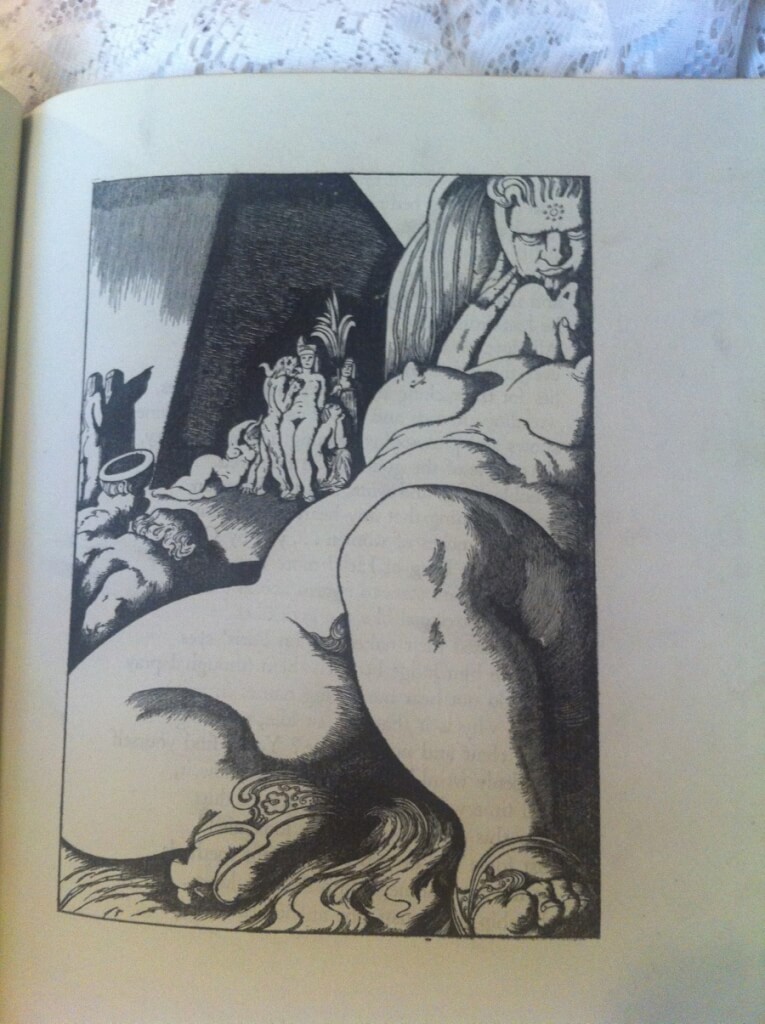 The Mimiambs of Herondas, Herodas, Translated by Jack Lindsay, Decorated by Alan Odle, with a Foreword by Brian Penton. (The Fanfrolico Press, London, nd [c. 1929], #351/375 [first edition, and first Fanfrolico to be printed in London]) 11 7/8" X 9 3/8", unpaginated 72pp, hardbound no DJ, original buckram-backed decorated Japanese paper boards with plain green cloth spine and gilt lettering, top edge gilt, other edges deckle, poor condition, boards show major wear, spine worn off, binding still good, boards still attached, interior pages are fine, Cloister types on Van Gelder Antique handmade paper Herodas was a Greek poet and the author of short humorous dramatic scenes in verse, written under the Alexandrian empire in the 3rd century BC. Mimes were scenes in popular life in South Italy and Sicily, written in the language of the people, vigorous with racy proverbs such as we get in other reflections of that region. The Mimes of Herodas have been known to us only since the discovery and publication of the "Kenyon", M. S. Buck, by the British Museum in 1891 (from a parchment containing 7 legible mimes half of the 8th and a fragment of the 9th). This was Fanfrolico's first London book. It was published "for subscribers to The Franfrolico Press". This new translation of Mimiambs of Herondas was translated by Jack Lindsay and beautifully illustrated by Alan Odle whose grotesque and subversive style was a precursor of surrealism. This is a beautiful printed book in great condition and quite rare. Fanfrolico Press, Australia’s first ‘private press’ in the arts-and-craft tradition, was founded by Jack Lindsay, P. R. Stephensen and John Kirtley, originally in North Sydney in 1923. The press specialized in printings artful, limited editions of classics and forgotten works that were suited to the extravagant style of artist like his father, artist, sculptor and author Norman Lindsay who illustrated many of their books. Fanfrolico was scornful of modernism and with its florid style determinedly backward-looking. They did surprisingly well, despite the lack of business expertise of their young, ambitious "bohemian" owners, eking out a living despite the risky move to London in 1926 and upheavals in ownership that saw the departure in 1927 of Kirtley, and then Stephenson in 1929. Sometime in 1930 they published their last book.
The Mimiambs of Herondas, Herodas, Translated by Jack Lindsay, Decorated by Alan Odle, with a Foreword by Brian Penton. (The Fanfrolico Press, London, nd [c. 1929], #351/375 [first edition, and first Fanfrolico to be printed in London]) 11 7/8" X 9 3/8", unpaginated 72pp, hardbound no DJ, original buckram-backed decorated Japanese paper boards with plain green cloth spine and gilt lettering, top edge gilt, other edges deckle, poor condition, boards show major wear, spine worn off, binding still good, boards still attached, interior pages are fine, Cloister types on Van Gelder Antique handmade paper Herodas was a Greek poet and the author of short humorous dramatic scenes in verse, written under the Alexandrian empire in the 3rd century BC. Mimes were scenes in popular life in South Italy and Sicily, written in the language of the people, vigorous with racy proverbs such as we get in other reflections of that region. The Mimes of Herodas have been known to us only since the discovery and publication of the "Kenyon", M. S. Buck, by the British Museum in 1891 (from a parchment containing 7 legible mimes half of the 8th and a fragment of the 9th). This was Fanfrolico's first London book. It was published "for subscribers to The Franfrolico Press". This new translation of Mimiambs of Herondas was translated by Jack Lindsay and beautifully illustrated by Alan Odle whose grotesque and subversive style was a precursor of surrealism. This is a beautiful printed book in great condition and quite rare. Fanfrolico Press, Australia’s first ‘private press’ in the arts-and-craft tradition, was founded by Jack Lindsay, P. R. Stephensen and John Kirtley, originally in North Sydney in 1923. The press specialized in printings artful, limited editions of classics and forgotten works that were suited to the extravagant style of artist like his father, artist, sculptor and author Norman Lindsay who illustrated many of their books. Fanfrolico was scornful of modernism and with its florid style determinedly backward-looking. They did surprisingly well, despite the lack of business expertise of their young, ambitious "bohemian" owners, eking out a living despite the risky move to London in 1926 and upheavals in ownership that saw the departure in 1927 of Kirtley, and then Stephenson in 1929. Sometime in 1930 they published their last book. -

 Les métamorphoses ou l'asne d'or de Luce Apulée philosophe platonique, Lucius Apuleius Madaurensis (124-170 AD), trans. Jules De Marthold, illust. [21 etchings] Martin van Maele (Charles Carrington, Librairie-Éditeur, 1905, Paris, #88/750) 9.25" X 6.25", xlviii+328pp., original soft wraps protected by glassine wraps, Chapter pieces in orange and black, tail pieces in black, large, decorative first letter of each chapter, frontispiece + 21 full-page b/w engravings with tissue guards and numerous in-text illustrations by Martin van Maele, very good condition for age. The Metamorphoses of Apuleius, which St. Augustine referred to as "The Golden Ass", is the only Ancient Roman novel in Latin to survive in its entirety. The plot Lucius and his curiosity and insatiable desire to see and practice magic. While trying to perform a spell to transform into a bird, he is accidentally transformed into an ass. This leads to a long journey, literal and metaphorical, filled with in-set tales. He finally finds salvation through the intervention of the goddess Isis, whose cult he joins. The date of the original work is uncertain. Scholars are not sure if he wrote it in his youth or at the end of his life. He adapted the story from a Greek story written by Lucius of Patrae, however his original Greek text has long been lost. Maurice François Alfred Martin van Miële (1863-5 - 1926), better known by his pseudonym Martin van Maële, was a French illustrator of early 20th century literature. Though he gained notoriety with his illustration for H. G. Wells in Les Premiers Hommes dans la Lune, and he worked as an illustrator for the Félix Juven's French translations of the Sherlock Holmes series, he is now most widely renowned and mostly remembered for his erotic illustrations. This is a beautiful and rare book in it's original paper wraps.
Les métamorphoses ou l'asne d'or de Luce Apulée philosophe platonique, Lucius Apuleius Madaurensis (124-170 AD), trans. Jules De Marthold, illust. [21 etchings] Martin van Maele (Charles Carrington, Librairie-Éditeur, 1905, Paris, #88/750) 9.25" X 6.25", xlviii+328pp., original soft wraps protected by glassine wraps, Chapter pieces in orange and black, tail pieces in black, large, decorative first letter of each chapter, frontispiece + 21 full-page b/w engravings with tissue guards and numerous in-text illustrations by Martin van Maele, very good condition for age. The Metamorphoses of Apuleius, which St. Augustine referred to as "The Golden Ass", is the only Ancient Roman novel in Latin to survive in its entirety. The plot Lucius and his curiosity and insatiable desire to see and practice magic. While trying to perform a spell to transform into a bird, he is accidentally transformed into an ass. This leads to a long journey, literal and metaphorical, filled with in-set tales. He finally finds salvation through the intervention of the goddess Isis, whose cult he joins. The date of the original work is uncertain. Scholars are not sure if he wrote it in his youth or at the end of his life. He adapted the story from a Greek story written by Lucius of Patrae, however his original Greek text has long been lost. Maurice François Alfred Martin van Miële (1863-5 - 1926), better known by his pseudonym Martin van Maële, was a French illustrator of early 20th century literature. Though he gained notoriety with his illustration for H. G. Wells in Les Premiers Hommes dans la Lune, and he worked as an illustrator for the Félix Juven's French translations of the Sherlock Holmes series, he is now most widely renowned and mostly remembered for his erotic illustrations. This is a beautiful and rare book in it's original paper wraps. -

 Manuel D'Érotologie Classique (de figuris Veneris) by Fred. Chas. Forberg, trans. Alcide Bonneau (Imprimé pour René Bonnel, Paris, 1933, #123/500) 6" x 9.25", 223pp, three quarter red leather, gilt titles on spine, 4 raised double bands, near fine condition, ribbon intact, hand-laid Arches paper (identifying watermarks), original paper covers bound in. Rene Bonnel, the publisher of this edition, was one of the foremost publishers of finely printed illegal erotica in the 1930's. This work was openly published and is no exception to the quality of his books. De figuris Veneris (On the figures of Venus) was an anthology of ancient Greek and ancient Roman writings on erotic topics, discussed objectively and classified and grouped by subject matter. (I. Of Copulation, II. Of Pederastia, III. Of Irrumation, IV. Of Masturbation, V. Of Cunnilingues, VI. Of Tribads, VII. Of Intercourse with Animals, VIII. Of Spintrian Postures) It was first published by the German classicist Friedrich Karl Forberg in 1824 in Latin and Greek as “Antonii Panormitae Hermaphroditus”, an erotic poem sequence in renaissance Latin. Forberg later reprinted it as “Manuel D’Érotologie Classique (de figuris Veneris)”. It was translated into English (published by Charles Carrington in 1899 and again by Charles Hirsch in 1907), French and German (one French edition was illustrated by Édouard-Henri Avril [Paul Avril]). It concludes with a list of 95 sexual positions. In 1899 Forberg's work was translated into English and published by Charles Carrington as De figuris Veneris, Manual of classical erotology, and again in 1907 by Charles Hirsch, and into French, German and Spanish. The French edition by Alcide Bonneau was titled Manuel d’érotologie classique. One French edition of 1906 was illustrated by Édouard-Henri Avril, which concludes with a list of 95 sexual positions. Most of the editions were restricted to high society or censored; one of the copies edited in France was immediately deposited on the secret shelves of the Bibliothèque nationale de France.
Manuel D'Érotologie Classique (de figuris Veneris) by Fred. Chas. Forberg, trans. Alcide Bonneau (Imprimé pour René Bonnel, Paris, 1933, #123/500) 6" x 9.25", 223pp, three quarter red leather, gilt titles on spine, 4 raised double bands, near fine condition, ribbon intact, hand-laid Arches paper (identifying watermarks), original paper covers bound in. Rene Bonnel, the publisher of this edition, was one of the foremost publishers of finely printed illegal erotica in the 1930's. This work was openly published and is no exception to the quality of his books. De figuris Veneris (On the figures of Venus) was an anthology of ancient Greek and ancient Roman writings on erotic topics, discussed objectively and classified and grouped by subject matter. (I. Of Copulation, II. Of Pederastia, III. Of Irrumation, IV. Of Masturbation, V. Of Cunnilingues, VI. Of Tribads, VII. Of Intercourse with Animals, VIII. Of Spintrian Postures) It was first published by the German classicist Friedrich Karl Forberg in 1824 in Latin and Greek as “Antonii Panormitae Hermaphroditus”, an erotic poem sequence in renaissance Latin. Forberg later reprinted it as “Manuel D’Érotologie Classique (de figuris Veneris)”. It was translated into English (published by Charles Carrington in 1899 and again by Charles Hirsch in 1907), French and German (one French edition was illustrated by Édouard-Henri Avril [Paul Avril]). It concludes with a list of 95 sexual positions. In 1899 Forberg's work was translated into English and published by Charles Carrington as De figuris Veneris, Manual of classical erotology, and again in 1907 by Charles Hirsch, and into French, German and Spanish. The French edition by Alcide Bonneau was titled Manuel d’érotologie classique. One French edition of 1906 was illustrated by Édouard-Henri Avril, which concludes with a list of 95 sexual positions. Most of the editions were restricted to high society or censored; one of the copies edited in France was immediately deposited on the secret shelves of the Bibliothèque nationale de France. -

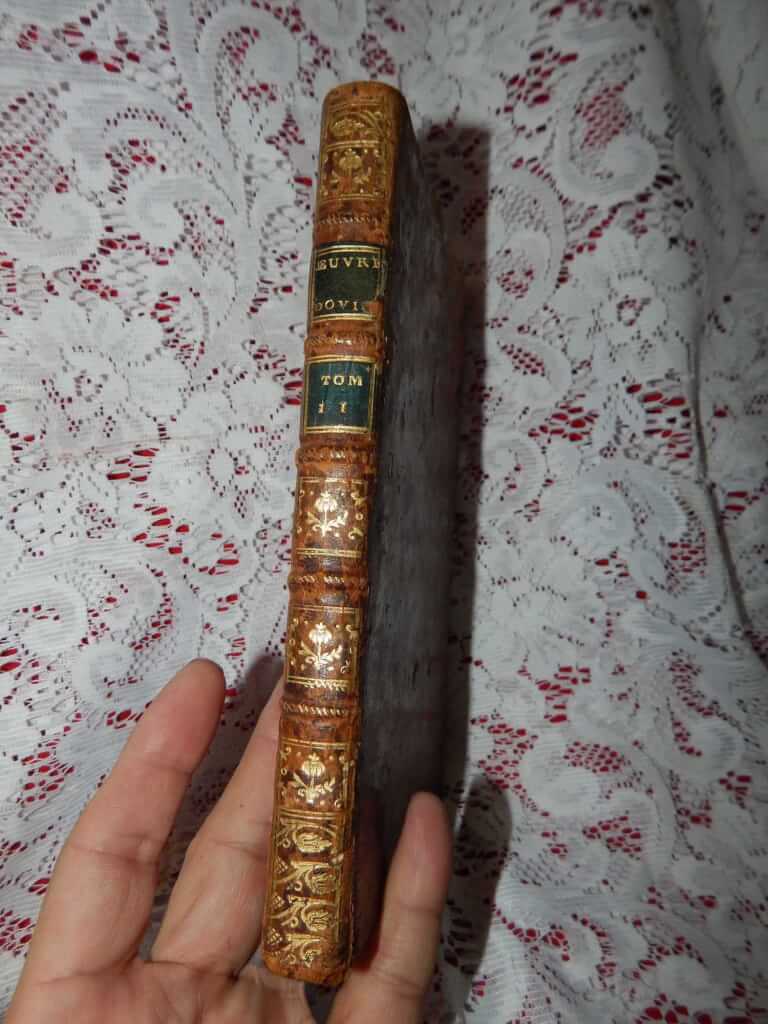 Les Œuvres Galantes et Amoureuses D'Ovide, contenant l'Art d'Aimer, le Remede d'Amour, les Épitre et les Élégies amoureuses, Nouvelle Édition (Vol 2 only of 2) (A Cythere, Aux Dépens du Loisir, 1774) 5"x8", 204pp, full calf, gilt titles and decorations to spine, 5 raised bands, marbled boards, good+ condition 2nd volume only beautifully bound, this volume contains the Art of Love, the Remedy of Love, the Letters and Elegies in Love, New Edition (Vol 2 only of 2) Publius Ovidius Naso (43 BC – AD 17/18), known as Ovid in the English-speaking world, was a Roman poet who lived during the reign of Augustus. He was a contemporary of the older Virgil and Horace, with whom he is often ranked as one of the three canonical poets of Latin literature. The Imperial scholar Quintilian considered him the last of the Latin love elegists. He enjoyed enormous popularity, but, in one of the mysteries of literary history, was sent by Augustus into exile in a remote province on the Black Sea, where he remained until his death. Ovid himself attributes his exile to carmen et error, "a poem and a mistake", but his discretion in discussing the causes has resulted in much speculation among scholars. The first major Roman poet to begin his career during the reign of Augustus, Ovid is today best known for the Metamorphoses, a 15-book continuous mythological narrative written in the meter of epic, and for works in elegiac couplets such as Ars Amatoria ("The Art of Love") and Fasti. His poetry was much imitated during Late Antiquity and the Middle Ages, and greatly influenced Western art and literature. The Metamorphoses remains one of the most important sources of classical mythology.
Les Œuvres Galantes et Amoureuses D'Ovide, contenant l'Art d'Aimer, le Remede d'Amour, les Épitre et les Élégies amoureuses, Nouvelle Édition (Vol 2 only of 2) (A Cythere, Aux Dépens du Loisir, 1774) 5"x8", 204pp, full calf, gilt titles and decorations to spine, 5 raised bands, marbled boards, good+ condition 2nd volume only beautifully bound, this volume contains the Art of Love, the Remedy of Love, the Letters and Elegies in Love, New Edition (Vol 2 only of 2) Publius Ovidius Naso (43 BC – AD 17/18), known as Ovid in the English-speaking world, was a Roman poet who lived during the reign of Augustus. He was a contemporary of the older Virgil and Horace, with whom he is often ranked as one of the three canonical poets of Latin literature. The Imperial scholar Quintilian considered him the last of the Latin love elegists. He enjoyed enormous popularity, but, in one of the mysteries of literary history, was sent by Augustus into exile in a remote province on the Black Sea, where he remained until his death. Ovid himself attributes his exile to carmen et error, "a poem and a mistake", but his discretion in discussing the causes has resulted in much speculation among scholars. The first major Roman poet to begin his career during the reign of Augustus, Ovid is today best known for the Metamorphoses, a 15-book continuous mythological narrative written in the meter of epic, and for works in elegiac couplets such as Ars Amatoria ("The Art of Love") and Fasti. His poetry was much imitated during Late Antiquity and the Middle Ages, and greatly influenced Western art and literature. The Metamorphoses remains one of the most important sources of classical mythology. -

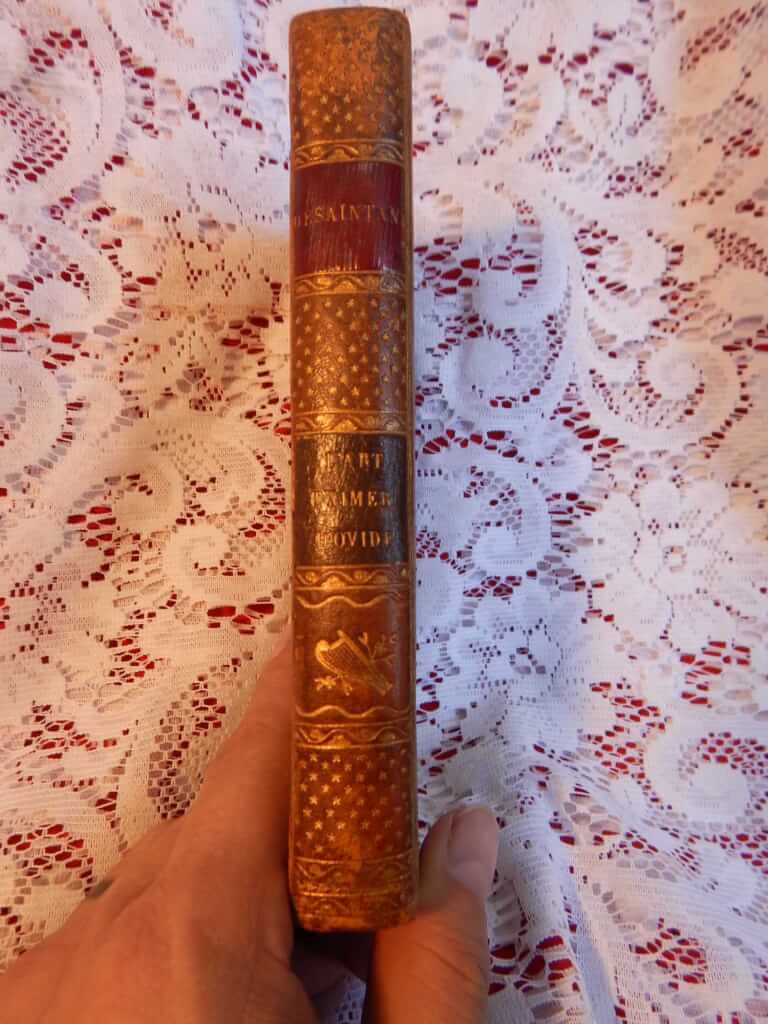 L'art d'aimer d'Ovide, traduction en vers, avec des remarques par M. Desaintange (Chez Giguet et Michaud, Paris, 1807, first edition of translation) 5"x8", 320pp, full calf, gilt titles and decorations to spine, marbled boards, some rubbing and bumping, good+ condition for age, finely engraved frontispiece, unknown artist French language translation by Saint-Ange of Ovid's The Art of Love. Publius Ovidius Naso (43 BC – AD 17/18), known as Ovid in the English-speaking world, was a Roman poet who lived during the reign of Augustus. He was a contemporary of the older Virgil and Horace, with whom he is often ranked as one of the three canonical poets of Latin literature. The Imperial scholar Quintilian considered him the last of the Latin love elegists. He enjoyed enormous popularity, but, in one of the mysteries of literary history, was sent by Augustus into exile in a remote province on the Black Sea, where he remained until his death. Ovid himself attributes his exile to carmen et error, "a poem and a mistake", but his discretion in discussing the causes has resulted in much speculation among scholars. The first major Roman poet to begin his career during the reign of Augustus, Ovid is today best known for the Metamorphoses, a 15-book continuous mythological narrative written in the meter of epic, and for works in elegiac couplets such as Ars Amatoria ("The Art of Love") and Fasti. His poetry was much imitated during Late Antiquity and the Middle Ages, and greatly influenced Western art and literature. The Metamorphoses remains one of the most important sources of classical mythology. Ange-François Fariau de Saint-Ange (1747-1810), known as Saint-Ange was a French poet and translator. Born of a father adviser of the king, he studied at the collège des jésuites de Blois, then at the college Sainte-Barbe de Paris. He acquired from a young age a reputation for his his unparalleled wit. Protected by Turgot, he gained a place in general control, but found himself without resources in the Revolution. At the fall of Robespierre, he found a job in the clothing agency of the troops, then became then professor of belles-lettres, then of general and reasoned grammar, with the central school of the street Saint-Antoine. He was elected member of the French Academy in 1810. In his reception speech, sensing that his shaky health would not allow him to sit there for a long time, he declared: "I am doing violence, at this moment, to the continual suffering and intolerable who warn me that the shadow of the academician whom I replace is waiting for mine. Three months later, he suffered a fall and died while visiting the institute.
L'art d'aimer d'Ovide, traduction en vers, avec des remarques par M. Desaintange (Chez Giguet et Michaud, Paris, 1807, first edition of translation) 5"x8", 320pp, full calf, gilt titles and decorations to spine, marbled boards, some rubbing and bumping, good+ condition for age, finely engraved frontispiece, unknown artist French language translation by Saint-Ange of Ovid's The Art of Love. Publius Ovidius Naso (43 BC – AD 17/18), known as Ovid in the English-speaking world, was a Roman poet who lived during the reign of Augustus. He was a contemporary of the older Virgil and Horace, with whom he is often ranked as one of the three canonical poets of Latin literature. The Imperial scholar Quintilian considered him the last of the Latin love elegists. He enjoyed enormous popularity, but, in one of the mysteries of literary history, was sent by Augustus into exile in a remote province on the Black Sea, where he remained until his death. Ovid himself attributes his exile to carmen et error, "a poem and a mistake", but his discretion in discussing the causes has resulted in much speculation among scholars. The first major Roman poet to begin his career during the reign of Augustus, Ovid is today best known for the Metamorphoses, a 15-book continuous mythological narrative written in the meter of epic, and for works in elegiac couplets such as Ars Amatoria ("The Art of Love") and Fasti. His poetry was much imitated during Late Antiquity and the Middle Ages, and greatly influenced Western art and literature. The Metamorphoses remains one of the most important sources of classical mythology. Ange-François Fariau de Saint-Ange (1747-1810), known as Saint-Ange was a French poet and translator. Born of a father adviser of the king, he studied at the collège des jésuites de Blois, then at the college Sainte-Barbe de Paris. He acquired from a young age a reputation for his his unparalleled wit. Protected by Turgot, he gained a place in general control, but found himself without resources in the Revolution. At the fall of Robespierre, he found a job in the clothing agency of the troops, then became then professor of belles-lettres, then of general and reasoned grammar, with the central school of the street Saint-Antoine. He was elected member of the French Academy in 1810. In his reception speech, sensing that his shaky health would not allow him to sit there for a long time, he declared: "I am doing violence, at this moment, to the continual suffering and intolerable who warn me that the shadow of the academician whom I replace is waiting for mine. Three months later, he suffered a fall and died while visiting the institute. -
 The Love Books of Ovid, A Completely Unexpurgated and Newly Translated Edition by Charles D. Young | Together with the Elegie, Translated by Christopher Marlowe | Illustrated by Alexander King "This book, designed by T. Spencer Hutson, was printed at the Alexander Hamilton Press, in March 1930. Illustrations are reproduced by the Knudson process. This edition consists of Two Thousand numbered copies printed on Strathmore MELDON deckle edge laid paper. This copy is No. 361" (Privately Published for Subscribers, Art Studio Books, Inc., 1930, #361/2000) 6.25"x9.5", iii+302pp, 3/4 black cloth over marbled boards, gilt text and decorations on spine, gilt borders on covers, marbled pastdowns, top edge gilt, other edges deckled, frontispiece and 16 full-page illustrations with descriptive tissue guards, other illustrations and titles in orange within text, near fine copy, slight rubbing at top and bottom of spine. This is a beautiful edition of 5 of his works, Ars Amatoria ("The Art of Love"), Remedia Amoris ("The Cure for Love"), Amores ("The Loves"), Medicamina Faciei ("dye on the face"), and his Elegies Publius Ovidius Naso (43 BC – AD 17/18), known as Ovid in the English-speaking world, was a Roman poet who lived during the reign of Augustus. He was a contemporary of the older Virgil and Horace, with whom he is often ranked as one of the three canonical poets of Latin literature. The Imperial scholar Quintilian considered him the last of the Latin love elegists. He enjoyed enormous popularity, but, in one of the mysteries of literary history, was sent by Augustus into exile in a remote province on the Black Sea, where he remained until his death. Ovid himself attributes his exile to carmen et error, "a poem and a mistake", but his discretion in discussing the causes has resulted in much speculation among scholars. The first major Roman poet to begin his career during the reign of Augustus, Ovid is today best known for the Metamorphoses, a 15-book continuous mythological narrative written in the meter of epic, and for works in elegiac couplets such as Ars Amatoria ("The Art of Love") and Fasti. His poetry was much imitated during Late Antiquity and the Middle Ages, and greatly influenced Western art and literature. The Metamorphoses remains one of the most important sources of classical mythology. Alexander King (1899–1965), born Alexander Koenig in Vienna, was a bestselling humorist, memoirist and media personality of the early television era, based in the United States. In his late fifties, after becoming a frequent guest on the a Tonight Show hosted by Jack Paar, King emerged as an incongruous presence in the realm of national celebrity: an aging, irascible raconteur, with elegant mannerisms and trademark bow-tie, who spoke frankly and disarmingly about his bohemian lifestyle, multiple marriages, and years-long struggle with drug addiction. His checkered past led TIME magazine to describe him as "an ex-illustrator, ex-cartoonist, ex-adman, ex-editor, ex-playwright, ex-dope addict. For a quarter-century he was an ex-painter, and by his own bizarre account qualifies as an ex-midwife. He is also an ex-husband to three wives and an ex-Viennese of sufficient age (60) to remember muttonchopped Emperor Franz Joseph. When doctors told him a few years ago that he might soon be an ex-patient (two strokes, serious kidney disease, peptic ulcer, high blood pressure), he sat down to tell gay stories of the life of all these earlier Kings."
The Love Books of Ovid, A Completely Unexpurgated and Newly Translated Edition by Charles D. Young | Together with the Elegie, Translated by Christopher Marlowe | Illustrated by Alexander King "This book, designed by T. Spencer Hutson, was printed at the Alexander Hamilton Press, in March 1930. Illustrations are reproduced by the Knudson process. This edition consists of Two Thousand numbered copies printed on Strathmore MELDON deckle edge laid paper. This copy is No. 361" (Privately Published for Subscribers, Art Studio Books, Inc., 1930, #361/2000) 6.25"x9.5", iii+302pp, 3/4 black cloth over marbled boards, gilt text and decorations on spine, gilt borders on covers, marbled pastdowns, top edge gilt, other edges deckled, frontispiece and 16 full-page illustrations with descriptive tissue guards, other illustrations and titles in orange within text, near fine copy, slight rubbing at top and bottom of spine. This is a beautiful edition of 5 of his works, Ars Amatoria ("The Art of Love"), Remedia Amoris ("The Cure for Love"), Amores ("The Loves"), Medicamina Faciei ("dye on the face"), and his Elegies Publius Ovidius Naso (43 BC – AD 17/18), known as Ovid in the English-speaking world, was a Roman poet who lived during the reign of Augustus. He was a contemporary of the older Virgil and Horace, with whom he is often ranked as one of the three canonical poets of Latin literature. The Imperial scholar Quintilian considered him the last of the Latin love elegists. He enjoyed enormous popularity, but, in one of the mysteries of literary history, was sent by Augustus into exile in a remote province on the Black Sea, where he remained until his death. Ovid himself attributes his exile to carmen et error, "a poem and a mistake", but his discretion in discussing the causes has resulted in much speculation among scholars. The first major Roman poet to begin his career during the reign of Augustus, Ovid is today best known for the Metamorphoses, a 15-book continuous mythological narrative written in the meter of epic, and for works in elegiac couplets such as Ars Amatoria ("The Art of Love") and Fasti. His poetry was much imitated during Late Antiquity and the Middle Ages, and greatly influenced Western art and literature. The Metamorphoses remains one of the most important sources of classical mythology. Alexander King (1899–1965), born Alexander Koenig in Vienna, was a bestselling humorist, memoirist and media personality of the early television era, based in the United States. In his late fifties, after becoming a frequent guest on the a Tonight Show hosted by Jack Paar, King emerged as an incongruous presence in the realm of national celebrity: an aging, irascible raconteur, with elegant mannerisms and trademark bow-tie, who spoke frankly and disarmingly about his bohemian lifestyle, multiple marriages, and years-long struggle with drug addiction. His checkered past led TIME magazine to describe him as "an ex-illustrator, ex-cartoonist, ex-adman, ex-editor, ex-playwright, ex-dope addict. For a quarter-century he was an ex-painter, and by his own bizarre account qualifies as an ex-midwife. He is also an ex-husband to three wives and an ex-Viennese of sufficient age (60) to remember muttonchopped Emperor Franz Joseph. When doctors told him a few years ago that he might soon be an ex-patient (two strokes, serious kidney disease, peptic ulcer, high blood pressure), he sat down to tell gay stories of the life of all these earlier Kings." -
 The Lysistrata of Aristophanes | Wholly translated into English and illustrated with eight full-page drawings by Aubrey Beardsley with a preface on Aristophanic Comedy and its reflection in the art of the Illustrator by George Frederic Lees, Aristophanes, illus. by Aubrey Beardsley, forward by George Frederic Lees (Privately Printed in Paris, 1931, #352/525) 11.25" X 9.25", 61pp, loosely bound with loose cover, with original slip-case, printed on hand-made Van Gelder paper, 8 illustrations printed on mould-made Annoy Paper, interior pages clean and in fine condition, slip-case is in poor condition, some soiling on the cover. Aristophanes was the greatest writer of ancient Athenian “old comedy,” known for its satires of contemporary life and for its broad, often obscene humor. Lysistrata was first produced in 411 BC, when the Peloponnesian War had been devastating Greece for 20 years. Most people know the plot: Lysistrata assembles women from all of Greece, and they agree that they will not have sex until the men make peace. Aubrey Beardsley was the greatest and the most controversial Art Nouveau illustrator in England, famous for his illustrations of Mallory’s Morte d’Arthur, Oscar Wilde’s Salome, Pope’s The Rape of the Lock, and for several magazines. Because he was associated with Oscar Wilde, Beardsley lost his job as art editor of a magazine named The Yellow Book in 1895, soon after Wilde was arrested for homosexuality. He was approached by Leonard Smithers, a publisher of erotic books, who asked him to illustrate Lysistrata. His illustrations are very much in the spirit of Aristophanes, as funny as they are obscene. Beardsley converted to Catholicism in 1897, and soon after, he asked Smithers to “destroy all copies of Lysistrata” with its “obscene drawings,” but Smithers refused. Beardsley died of tuberculosis in 1898, at the age of 26. Smithers initially published Lysistrata in a limited edition of one hundred copies. It was occasionally reprinted in very small runs, usually clandestinely, often poorly, but copies have long been scarce and expensive. I have only found this copy a few places outside of museums and libraries. This is a rare fine reproduction of the original drawings on quality paper. I do not have information about the actual publisher.
The Lysistrata of Aristophanes | Wholly translated into English and illustrated with eight full-page drawings by Aubrey Beardsley with a preface on Aristophanic Comedy and its reflection in the art of the Illustrator by George Frederic Lees, Aristophanes, illus. by Aubrey Beardsley, forward by George Frederic Lees (Privately Printed in Paris, 1931, #352/525) 11.25" X 9.25", 61pp, loosely bound with loose cover, with original slip-case, printed on hand-made Van Gelder paper, 8 illustrations printed on mould-made Annoy Paper, interior pages clean and in fine condition, slip-case is in poor condition, some soiling on the cover. Aristophanes was the greatest writer of ancient Athenian “old comedy,” known for its satires of contemporary life and for its broad, often obscene humor. Lysistrata was first produced in 411 BC, when the Peloponnesian War had been devastating Greece for 20 years. Most people know the plot: Lysistrata assembles women from all of Greece, and they agree that they will not have sex until the men make peace. Aubrey Beardsley was the greatest and the most controversial Art Nouveau illustrator in England, famous for his illustrations of Mallory’s Morte d’Arthur, Oscar Wilde’s Salome, Pope’s The Rape of the Lock, and for several magazines. Because he was associated with Oscar Wilde, Beardsley lost his job as art editor of a magazine named The Yellow Book in 1895, soon after Wilde was arrested for homosexuality. He was approached by Leonard Smithers, a publisher of erotic books, who asked him to illustrate Lysistrata. His illustrations are very much in the spirit of Aristophanes, as funny as they are obscene. Beardsley converted to Catholicism in 1897, and soon after, he asked Smithers to “destroy all copies of Lysistrata” with its “obscene drawings,” but Smithers refused. Beardsley died of tuberculosis in 1898, at the age of 26. Smithers initially published Lysistrata in a limited edition of one hundred copies. It was occasionally reprinted in very small runs, usually clandestinely, often poorly, but copies have long been scarce and expensive. I have only found this copy a few places outside of museums and libraries. This is a rare fine reproduction of the original drawings on quality paper. I do not have information about the actual publisher. -
 The Golden Ass of Apuleius, Lucius Apuleius Madaurensis (124-170 AD), trans. & intro Francis D. Byrne (The Imperial Press[Charles Carrington?], London, n.d. [1904?], #257/650) 7.75" X 5.75", xlix+388pp., 1/4 maroon morrocco over marbled boards with gilt titles and 4 raised bands on spine, top edge gilt The Metamorphoses of Apuleius, which St. Augustine referred to as “The Golden Ass”, is the only Ancient Roman novel in Latin to survive in its entirety. The plot Lucius and his curiosity and insatiable desire to see and practice magic. While trying to perform a spell to transform into a bird, he is accidentally transformed into an ass. This leads to a long journey, literal and metaphorical, filled with in-set tales. He finally finds salvation through the intervention of the goddess Isis, whose cult he joins. The date of the original work is uncertain. Scholars are not sure if he wrote it in his youth or at the end of his life. He adapted the story from a Greek story written by Lucius of Patrae, however his original Greek text has long been lost.
The Golden Ass of Apuleius, Lucius Apuleius Madaurensis (124-170 AD), trans. & intro Francis D. Byrne (The Imperial Press[Charles Carrington?], London, n.d. [1904?], #257/650) 7.75" X 5.75", xlix+388pp., 1/4 maroon morrocco over marbled boards with gilt titles and 4 raised bands on spine, top edge gilt The Metamorphoses of Apuleius, which St. Augustine referred to as “The Golden Ass”, is the only Ancient Roman novel in Latin to survive in its entirety. The plot Lucius and his curiosity and insatiable desire to see and practice magic. While trying to perform a spell to transform into a bird, he is accidentally transformed into an ass. This leads to a long journey, literal and metaphorical, filled with in-set tales. He finally finds salvation through the intervention of the goddess Isis, whose cult he joins. The date of the original work is uncertain. Scholars are not sure if he wrote it in his youth or at the end of his life. He adapted the story from a Greek story written by Lucius of Patrae, however his original Greek text has long been lost. -

 The Mimes of Herondas, trans. M. S. Buck (Privately Printed for Subscribers, New York, 1921, #919/975) 7" X 4 5/8", 119pp, hardbound no DJ, paper boards with beige cloth spine, top edge gilt, others deckle, good condition, lightly soiled Herodas was a Greek poet and the author of short humorous dramatic scenes in verse, written under the Alexandrian empire in the 3rd century BC. Mimes were scenes in popular life in South Italy and Sicily, written in the language of the people, vigorous with racy proverbs such as we get in other reflections of that region. The Mimes of Herodas have been known to us only since the discovery and publication of the "Kenyon", M. S. Buck, by the British Museum in 1891 (from a parchment containing 7 legible mimes half of the 8th and a fragment of the 9th).
The Mimes of Herondas, trans. M. S. Buck (Privately Printed for Subscribers, New York, 1921, #919/975) 7" X 4 5/8", 119pp, hardbound no DJ, paper boards with beige cloth spine, top edge gilt, others deckle, good condition, lightly soiled Herodas was a Greek poet and the author of short humorous dramatic scenes in verse, written under the Alexandrian empire in the 3rd century BC. Mimes were scenes in popular life in South Italy and Sicily, written in the language of the people, vigorous with racy proverbs such as we get in other reflections of that region. The Mimes of Herodas have been known to us only since the discovery and publication of the "Kenyon", M. S. Buck, by the British Museum in 1891 (from a parchment containing 7 legible mimes half of the 8th and a fragment of the 9th). -
 Sappho: memoir, text, selected renderings, and a literal translation by Henry Thorton Wharton, Sappho, trans. Henry Thornton Wharton, M.A. Oxon. (John Lane [Bodley Head], London, A.C. McClurg & Co, Chicago, 1895 (third edition)) 7.25″ X 4.75″, xx 217pp + 16pp publisher’s list, hardbound, the third edition (this being the first to have its boards decorated by Aubrey Beardsley) green cloth boards with gilt decorations and titles on spine, bottom of the spine states “The Bodley Head and Chicago” reflecting the two publishing houses, top edge gilt, others deckled. Good condition for age, short tear on spine, binding and hinges good, newspaper article attached to back page “A Newly-Found Poem by Sappho” Sappho was a Greek lyric poet, born on the island of Lesbos. The Alexandrians included her in the list of nine lyric poets. Her birth was sometime between 630 and 612 BC, and it is said that she died around 570 BC, but little is known for certain about her life. The bulk of her poetry, which was well-known and greatly admired through much of antiquity, has been lost. But, her immense reputation has endured through surviving fragments. Sappho's poetry centers on passion and love for various people and both sexes. The word lesbian derives from the name of the island of her birth, Lesbos, while her name is also the origin of the word sapphic; neither word was applied to female homosexuality until the 19th century, after this translation by Wharton, the first English translation to acknowledge it. Originally John Lane and Elkin Mathews — The Bodley Head was a partnership set up in 1887 by John Lane (1854–1925) and Elkin Mathews (1851–1921), to trade in antiquarian books in London. It took its name from a bust of Sir Thomas Bodley, the eponymist of the Bodleian Library in Oxford, above the shop door. Lane and Mathews began in 1894 to publish works of ‘stylish decadence’, including the notorious literary periodical The Yellow Book. A. C. McClurg was a Chicago, Illinois based publisher made famous by their original publishing of the Tarzan of the Apes novels and other stories of Edgar Rice Burroughs.
Sappho: memoir, text, selected renderings, and a literal translation by Henry Thorton Wharton, Sappho, trans. Henry Thornton Wharton, M.A. Oxon. (John Lane [Bodley Head], London, A.C. McClurg & Co, Chicago, 1895 (third edition)) 7.25″ X 4.75″, xx 217pp + 16pp publisher’s list, hardbound, the third edition (this being the first to have its boards decorated by Aubrey Beardsley) green cloth boards with gilt decorations and titles on spine, bottom of the spine states “The Bodley Head and Chicago” reflecting the two publishing houses, top edge gilt, others deckled. Good condition for age, short tear on spine, binding and hinges good, newspaper article attached to back page “A Newly-Found Poem by Sappho” Sappho was a Greek lyric poet, born on the island of Lesbos. The Alexandrians included her in the list of nine lyric poets. Her birth was sometime between 630 and 612 BC, and it is said that she died around 570 BC, but little is known for certain about her life. The bulk of her poetry, which was well-known and greatly admired through much of antiquity, has been lost. But, her immense reputation has endured through surviving fragments. Sappho's poetry centers on passion and love for various people and both sexes. The word lesbian derives from the name of the island of her birth, Lesbos, while her name is also the origin of the word sapphic; neither word was applied to female homosexuality until the 19th century, after this translation by Wharton, the first English translation to acknowledge it. Originally John Lane and Elkin Mathews — The Bodley Head was a partnership set up in 1887 by John Lane (1854–1925) and Elkin Mathews (1851–1921), to trade in antiquarian books in London. It took its name from a bust of Sir Thomas Bodley, the eponymist of the Bodleian Library in Oxford, above the shop door. Lane and Mathews began in 1894 to publish works of ‘stylish decadence’, including the notorious literary periodical The Yellow Book. A. C. McClurg was a Chicago, Illinois based publisher made famous by their original publishing of the Tarzan of the Apes novels and other stories of Edgar Rice Burroughs. -
 The Ragionamenti or dialogues of the devine Pietro Aretino, Pietro Aretino, trans. Isidore Liseux (Isidore Liseux, Paris, 1889) 8" X 6", 3 volumes, xxxv+83+89pp, 100+134pp, 129+138pp, half-bound brown morocco over marbled boards, gilt titles on spines, top-edge gilt, other edges deckled, each book has the ex-libris of Boies Penrose II Pietro Aretino (1492-1556) was one of the most important figures in Italian Renaissance literature, and certainly the most controversial. Condemned by some as a pornographer, his infamy was due largely to his use of explicit sexuality and the vulgar tongue of ordinary speech in much of his work. Dialogues center around a conversation between two rather frank, experienced, and sharp-tongued women on the topic of women’s occupations. We learn that at the time there were only three: wife, whore, or nun. Their discussion is a rollicking account of the advantages, perils, and pleasures each profession offers. Not only was Dialogues the first erotic book in the Christian world to be written in the common vernacular, it was but one of the few to describe the obscenity of commercial love, and is thus a cornerstone of both Italian literature and Counter-Renaissance vigour. First dialog: The Life of Nuns Second dialog: The Life of Married Women Third dialog: The Life of Courtesans Fourth dialog: The Education of Pippa Fifth dialog: The Wiles of Men Sixth dialog: The Bawd’s Trade Isidore Liseux (1835-1894) was a French bibliophile and publisher of erotica and curiosa. His publications were mostly rare texts of 16th to 18th century authors, hard to find and little known books which were usually translated and annotated by his friend and associate Alcide Bonneau or by Liseux himself. Liseux and Bonneau, both ex-priests, knew each other since seminary. His books were published in small numbers, on high quality paper, and with excellent typography. His usual printers were Claude Motteroz, Antoine Bécus, and later Charles Unsinger. Liseux’s books were published openly as the climate was more permissive in Paris at the time. His books were so well regarded that pirates of his books and even unrelated books bearing his imprint with a false date were published clandestinely into the 20th century. French poet, Guillaume Apollinaire wrote: “The publications of Liseux are more and more sought after because they are correct, beautiful and rare.” (Le flaneur des deux rives, 1918). Time Magazine, Monday, May 11, 1936 Youngish Pennsylvanians whose Progressive fathers frightened them with the name of BOIES PENROSE a quarter century ago could look forward last week to bemusing their own children with that great name some day. In Philadelphia Boies Penrose II, nephew of Pennsylvania's longtime (1897-1921) Senator and Republican boss, received a Republican nomination to Congress in last week's primary. A rich and cultured Harvard man like his late uncle, 34-year-old Boies II has hitherto devoted himself to scholarship and society, is the owner of a notable collection of etchings, engravings, manuscripts and rare books. When he decided few months ago to make a career for himself in politics, leaders of Philadelphia's Republican machine warmly welcomed a young man with so potent a name, so fat a pocketbook. Candidate Penrose, who owns a 125-acre estate on the Main Line at swank Devon where he takes his own and neighbors' small children for rides on his mile-long miniature railroad, promptly established a residence in Philadelphia by renting an apartment, the address of which he is constantly forgetting.— "My platform," he announced in fastidious Bostonese, "will be the Horse & Buggy, or Save the Constitution." In the Republican split of 1912 Boies Penrose temporarily lost his State leadership to the Bull Moose faction, which included an ardent Young Roosevelt worshipper named Gifford Pinchot. While one set of Philadelphia voters was lifting the name of Penrose up last week, another group was setting the name of Pinchot down. In a district inhabited largely by factory workers whose cause she has championed many a time on the picket line, red-haired Mrs. Gifford Pinchot made her third race for a Republican nomination to the House, suffered her third defeat.
The Ragionamenti or dialogues of the devine Pietro Aretino, Pietro Aretino, trans. Isidore Liseux (Isidore Liseux, Paris, 1889) 8" X 6", 3 volumes, xxxv+83+89pp, 100+134pp, 129+138pp, half-bound brown morocco over marbled boards, gilt titles on spines, top-edge gilt, other edges deckled, each book has the ex-libris of Boies Penrose II Pietro Aretino (1492-1556) was one of the most important figures in Italian Renaissance literature, and certainly the most controversial. Condemned by some as a pornographer, his infamy was due largely to his use of explicit sexuality and the vulgar tongue of ordinary speech in much of his work. Dialogues center around a conversation between two rather frank, experienced, and sharp-tongued women on the topic of women’s occupations. We learn that at the time there were only three: wife, whore, or nun. Their discussion is a rollicking account of the advantages, perils, and pleasures each profession offers. Not only was Dialogues the first erotic book in the Christian world to be written in the common vernacular, it was but one of the few to describe the obscenity of commercial love, and is thus a cornerstone of both Italian literature and Counter-Renaissance vigour. First dialog: The Life of Nuns Second dialog: The Life of Married Women Third dialog: The Life of Courtesans Fourth dialog: The Education of Pippa Fifth dialog: The Wiles of Men Sixth dialog: The Bawd’s Trade Isidore Liseux (1835-1894) was a French bibliophile and publisher of erotica and curiosa. His publications were mostly rare texts of 16th to 18th century authors, hard to find and little known books which were usually translated and annotated by his friend and associate Alcide Bonneau or by Liseux himself. Liseux and Bonneau, both ex-priests, knew each other since seminary. His books were published in small numbers, on high quality paper, and with excellent typography. His usual printers were Claude Motteroz, Antoine Bécus, and later Charles Unsinger. Liseux’s books were published openly as the climate was more permissive in Paris at the time. His books were so well regarded that pirates of his books and even unrelated books bearing his imprint with a false date were published clandestinely into the 20th century. French poet, Guillaume Apollinaire wrote: “The publications of Liseux are more and more sought after because they are correct, beautiful and rare.” (Le flaneur des deux rives, 1918). Time Magazine, Monday, May 11, 1936 Youngish Pennsylvanians whose Progressive fathers frightened them with the name of BOIES PENROSE a quarter century ago could look forward last week to bemusing their own children with that great name some day. In Philadelphia Boies Penrose II, nephew of Pennsylvania's longtime (1897-1921) Senator and Republican boss, received a Republican nomination to Congress in last week's primary. A rich and cultured Harvard man like his late uncle, 34-year-old Boies II has hitherto devoted himself to scholarship and society, is the owner of a notable collection of etchings, engravings, manuscripts and rare books. When he decided few months ago to make a career for himself in politics, leaders of Philadelphia's Republican machine warmly welcomed a young man with so potent a name, so fat a pocketbook. Candidate Penrose, who owns a 125-acre estate on the Main Line at swank Devon where he takes his own and neighbors' small children for rides on his mile-long miniature railroad, promptly established a residence in Philadelphia by renting an apartment, the address of which he is constantly forgetting.— "My platform," he announced in fastidious Bostonese, "will be the Horse & Buggy, or Save the Constitution." In the Republican split of 1912 Boies Penrose temporarily lost his State leadership to the Bull Moose faction, which included an ardent Young Roosevelt worshipper named Gifford Pinchot. While one set of Philadelphia voters was lifting the name of Penrose up last week, another group was setting the name of Pinchot down. In a district inhabited largely by factory workers whose cause she has championed many a time on the picket line, red-haired Mrs. Gifford Pinchot made her third race for a Republican nomination to the House, suffered her third defeat. -
 The Ragionamenti or dialogues of the devine Pietro Aretino, Pietro Aretino, trans. Isidore Liseux (Isidore Liseux, Paris, 1889) 8.25" X 6", 6 volumes, xxxv+83pp, 89pp, 100pp, 134pp, 129pp, 138pp, original publishers paper wraps in just good condition with chipping at the top and bottom of the spine on some volumes, internal pages in mint condition, protective cover with green boards in fair condition, some joints loose and cloth peeling away, edges deckled, ex-libris of E. M. Schnadig Pietro Aretino (1492-1556) was one of the most important figures in Italian Renaissance literature, and certainly the most controversial. Condemned by some as a pornographer, his infamy was due largely to his use of explicit sexuality and the vulgar tongue of ordinary speech in much of his work. Dialogues center around a conversation between two rather frank, experienced, and sharp-tongued women on the topic of women’s occupations. We learn that at the time there were only three: wife, whore, or nun. Their discussion is a rollicking account of the advantages, perils, and pleasures each profession offers. Not only was Dialogues the first erotic book in the Christian world to be written in the common vernacular, it was but one of the few to describe the obscenity of commercial love, and is thus a cornerstone of both Italian literature and Counter-Renaissance vigour. First dialog: The Life of Nuns Second dialog: The Life of Married Women Third dialog: The Life of Courtesans Fourth dialog: The Education of Pippa Fifth dialog: The Wiles of Men Sixth dialog: The Bawd’s Trade Isidore Liseux (1835-1894) was a French bibliophile and publisher of erotica and curiosa. His publications were mostly rare texts of 16th to 18th century authors, hard to find and little known books which were usually translated and annotated by his friend and associate Alcide Bonneau or by Liseux himself. Liseux and Bonneau, both ex-priests, knew each other since seminary. His books were published in small numbers, on high quality paper, and with excellent typography. His usual printers were Claude Motteroz, Antoine Bécus, and later Charles Unsinger. Liseux’s books were published openly as the climate was more permissive in Paris at the time. His books were so well regarded that pirates of his books and even unrelated books bearing his imprint with a false date were published clandestinely into the 20th century. French poet, Guillaume Apollinaire wrote: “The publications of Liseux are more and more sought after because they are correct, beautiful and rare.” (Le flaneur des deux rives, 1918).
The Ragionamenti or dialogues of the devine Pietro Aretino, Pietro Aretino, trans. Isidore Liseux (Isidore Liseux, Paris, 1889) 8.25" X 6", 6 volumes, xxxv+83pp, 89pp, 100pp, 134pp, 129pp, 138pp, original publishers paper wraps in just good condition with chipping at the top and bottom of the spine on some volumes, internal pages in mint condition, protective cover with green boards in fair condition, some joints loose and cloth peeling away, edges deckled, ex-libris of E. M. Schnadig Pietro Aretino (1492-1556) was one of the most important figures in Italian Renaissance literature, and certainly the most controversial. Condemned by some as a pornographer, his infamy was due largely to his use of explicit sexuality and the vulgar tongue of ordinary speech in much of his work. Dialogues center around a conversation between two rather frank, experienced, and sharp-tongued women on the topic of women’s occupations. We learn that at the time there were only three: wife, whore, or nun. Their discussion is a rollicking account of the advantages, perils, and pleasures each profession offers. Not only was Dialogues the first erotic book in the Christian world to be written in the common vernacular, it was but one of the few to describe the obscenity of commercial love, and is thus a cornerstone of both Italian literature and Counter-Renaissance vigour. First dialog: The Life of Nuns Second dialog: The Life of Married Women Third dialog: The Life of Courtesans Fourth dialog: The Education of Pippa Fifth dialog: The Wiles of Men Sixth dialog: The Bawd’s Trade Isidore Liseux (1835-1894) was a French bibliophile and publisher of erotica and curiosa. His publications were mostly rare texts of 16th to 18th century authors, hard to find and little known books which were usually translated and annotated by his friend and associate Alcide Bonneau or by Liseux himself. Liseux and Bonneau, both ex-priests, knew each other since seminary. His books were published in small numbers, on high quality paper, and with excellent typography. His usual printers were Claude Motteroz, Antoine Bécus, and later Charles Unsinger. Liseux’s books were published openly as the climate was more permissive in Paris at the time. His books were so well regarded that pirates of his books and even unrelated books bearing his imprint with a false date were published clandestinely into the 20th century. French poet, Guillaume Apollinaire wrote: “The publications of Liseux are more and more sought after because they are correct, beautiful and rare.” (Le flaneur des deux rives, 1918). -
 Les métamorphoses ou l’asne d’or de Luce Apulée philosophe platonique, Lucius Apuleius Madaurensis (124-170 AD), trans. Jules De Montlyald, preface by Jules de Marthold, illust. [21 etchings] Martin van Maele (Charles Carrington, Librairie-Éditeur, 1905, Paris, #115/750) 6.25" X 9.25", xlviii+328pp, beautifully bound in three-quarter morocco over marbled boards with gilt titles and decorations on the spine, top-edge gilt, others uncut, fine condition overall, 21 full-page tipped-in B/W engravings with tissue guards and numerous in-text illustrations by Martin van Meale, red ribbon intact. The Metamorphoses of Apuleius, which St. Augustine referred to as “The Golden Ass”, is the only Ancient Roman novel in Latin to survive in its entirety. The plot Lucius and his curiosity and insatiable desire to see and practice magic. While trying to perform a spell to transform into a bird, he is accidentally transformed into an ass. This leads to a long journey, literal and metaphorical, filled with in-set tales. He finally finds salvation through the intervention of the goddess Isis, whose cult he joins. The date of the original work is uncertain. Scholars are not sure if he wrote it in his youth or at the end of his life. He adapted the story from a Greek story written by Lucius of Patrae, however his original Greek text has long been lost. Maurice François Alfred Martin van Miële (1863-5 – 1926), better known by his pseudonym Martin van Maële, was a French illustrator of early 20th century literature. Though he gained notoriety with his illustration for H. G. Wells in Les Premiers Hommes dans la Lune, and he worked as an illustrator for the Félix Juven’s French translations of the Sherlock Holmes series, he is now most widely renowned and mostly remembered for his erotic illustrations.
Les métamorphoses ou l’asne d’or de Luce Apulée philosophe platonique, Lucius Apuleius Madaurensis (124-170 AD), trans. Jules De Montlyald, preface by Jules de Marthold, illust. [21 etchings] Martin van Maele (Charles Carrington, Librairie-Éditeur, 1905, Paris, #115/750) 6.25" X 9.25", xlviii+328pp, beautifully bound in three-quarter morocco over marbled boards with gilt titles and decorations on the spine, top-edge gilt, others uncut, fine condition overall, 21 full-page tipped-in B/W engravings with tissue guards and numerous in-text illustrations by Martin van Meale, red ribbon intact. The Metamorphoses of Apuleius, which St. Augustine referred to as “The Golden Ass”, is the only Ancient Roman novel in Latin to survive in its entirety. The plot Lucius and his curiosity and insatiable desire to see and practice magic. While trying to perform a spell to transform into a bird, he is accidentally transformed into an ass. This leads to a long journey, literal and metaphorical, filled with in-set tales. He finally finds salvation through the intervention of the goddess Isis, whose cult he joins. The date of the original work is uncertain. Scholars are not sure if he wrote it in his youth or at the end of his life. He adapted the story from a Greek story written by Lucius of Patrae, however his original Greek text has long been lost. Maurice François Alfred Martin van Miële (1863-5 – 1926), better known by his pseudonym Martin van Maële, was a French illustrator of early 20th century literature. Though he gained notoriety with his illustration for H. G. Wells in Les Premiers Hommes dans la Lune, and he worked as an illustrator for the Félix Juven’s French translations of the Sherlock Holmes series, he is now most widely renowned and mostly remembered for his erotic illustrations. -
 The Golden Ass of Apuleius, a new translation with introduction and notes by Francis D. Byrne, Lucius Apuleius Madaurensis (124-170 AD), trans. Francis D Byrne, illust. [20 etchings] Martin van Maele (Classical Translation Union, Privately Issued for the Subscribers [Charles Carrington], 1904, Paris, #304/750) 6" X 8", xlix+588pp, blue boards with gilt decorations and titles, top-edge gilt, others deckled, some light foxing in the first few pages, advertisements on last few pages (all Carrington works). The Metamorphoses of Apuleius, which St. Augustine referred to as “The Golden Ass”, is the only Ancient Roman novel in Latin to survive in its entirety. The plot Lucius and his curiosity and insatiable desire to see and practice magic. While trying to perform a spell to transform into a bird, he is accidentally transformed into an ass. This leads to a long journey, literal and metaphorical, filled with in-set tales. He finally finds salvation through the intervention of the goddess Isis, whose cult he joins. The date of the original work is uncertain. Scholars are not sure if he wrote it in his youth or at the end of his life. He adapted the story from a Greek story written by Lucius of Patrae, however his original Greek text has long been lost. Maurice François Alfred Martin van Miële (1863-5 – 1926), better known by his pseudonym Martin van Maële, was a French illustrator of early 20th century literature. Though he gained notoriety with his illustration for H. G. Wells in Les Premiers Hommes dans la Lune, and he worked as an illustrator for the Félix Juven’s French translations of the Sherlock Holmes series, he is now most widely renowned and mostly remembered for his erotic illustrations.
The Golden Ass of Apuleius, a new translation with introduction and notes by Francis D. Byrne, Lucius Apuleius Madaurensis (124-170 AD), trans. Francis D Byrne, illust. [20 etchings] Martin van Maele (Classical Translation Union, Privately Issued for the Subscribers [Charles Carrington], 1904, Paris, #304/750) 6" X 8", xlix+588pp, blue boards with gilt decorations and titles, top-edge gilt, others deckled, some light foxing in the first few pages, advertisements on last few pages (all Carrington works). The Metamorphoses of Apuleius, which St. Augustine referred to as “The Golden Ass”, is the only Ancient Roman novel in Latin to survive in its entirety. The plot Lucius and his curiosity and insatiable desire to see and practice magic. While trying to perform a spell to transform into a bird, he is accidentally transformed into an ass. This leads to a long journey, literal and metaphorical, filled with in-set tales. He finally finds salvation through the intervention of the goddess Isis, whose cult he joins. The date of the original work is uncertain. Scholars are not sure if he wrote it in his youth or at the end of his life. He adapted the story from a Greek story written by Lucius of Patrae, however his original Greek text has long been lost. Maurice François Alfred Martin van Miële (1863-5 – 1926), better known by his pseudonym Martin van Maële, was a French illustrator of early 20th century literature. Though he gained notoriety with his illustration for H. G. Wells in Les Premiers Hommes dans la Lune, and he worked as an illustrator for the Félix Juven’s French translations of the Sherlock Holmes series, he is now most widely renowned and mostly remembered for his erotic illustrations. -
 The Golden Ass of Apuleius, Lucius Apuleius Madaurensis (124-170 AD), trans. & intro Francis D. Byrne (The Imperial Press[Charles Carrington?], London, n.d. [1904?]) 8.25" X 6.25", xlix+588pp., hardbound, blue cloth boards with paper label on spine, top edge gilt, other edges deckled, just good condition, tearing to top of spine, no illustrations present. The Metamorphoses of Apuleius, which St. Augustine referred to as “The Golden Ass”, is the only Ancient Roman novel in Latin to survive in its entirety. The plot Lucius and his curiosity and insatiable desire to see and practice magic. While trying to perform a spell to transform into a bird, he is accidentally transformed into an ass. This leads to a long journey, literal and metaphorical, filled with in-set tales. He finally finds salvation through the intervention of the goddess Isis, whose cult he joins. The date of the original work is uncertain. Scholars are not sure if he wrote it in his youth or at the end of his life. He adapted the story from a Greek story written by Lucius of Patrae, however his original Greek text has long been lost.
The Golden Ass of Apuleius, Lucius Apuleius Madaurensis (124-170 AD), trans. & intro Francis D. Byrne (The Imperial Press[Charles Carrington?], London, n.d. [1904?]) 8.25" X 6.25", xlix+588pp., hardbound, blue cloth boards with paper label on spine, top edge gilt, other edges deckled, just good condition, tearing to top of spine, no illustrations present. The Metamorphoses of Apuleius, which St. Augustine referred to as “The Golden Ass”, is the only Ancient Roman novel in Latin to survive in its entirety. The plot Lucius and his curiosity and insatiable desire to see and practice magic. While trying to perform a spell to transform into a bird, he is accidentally transformed into an ass. This leads to a long journey, literal and metaphorical, filled with in-set tales. He finally finds salvation through the intervention of the goddess Isis, whose cult he joins. The date of the original work is uncertain. Scholars are not sure if he wrote it in his youth or at the end of his life. He adapted the story from a Greek story written by Lucius of Patrae, however his original Greek text has long been lost.
